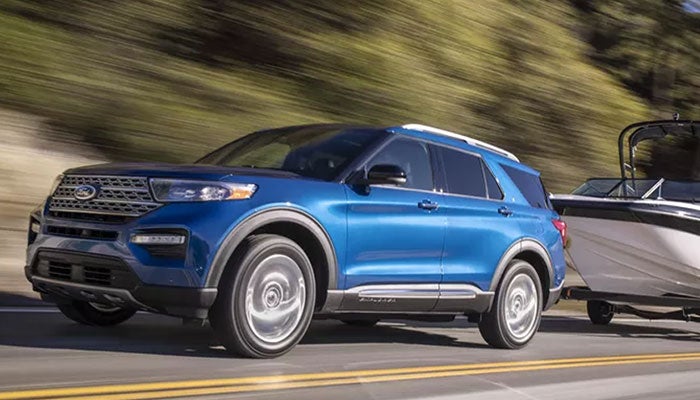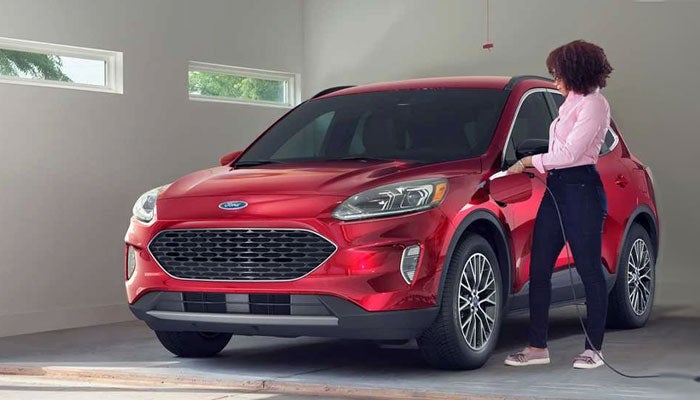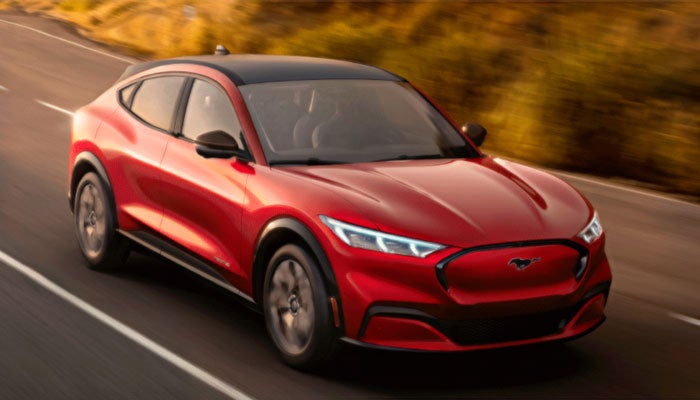EV Info
EV Information
WHAT IS AN EV?
All EVs feature a rechargeable, high-voltage battery that powers an electric motor. Yet with three EV designs — hybrid, plug-in hybrid and all-electric — there are some key differences. Here's what sets them apart:

HYBRID
- A gasoline engine and an electric motor work together to drive the vehicle
- A hybrid does not need to be plugged in - the high-voltage battery charges while the gasoline engine is running and also uses regenerative braking to capture energy used by the brakes

PLUG-IN HYBRID
- To recharge the high-voltage battery, drivers plug the vehicle into a wall outlet or charging station
- Has a higher capacity batter than a hybrid and can go farther on battery power
- Operates like a hybrid when the battery is depleted

ALL-ELECTRIC
- Operates the electric motor exclusively on battery power - there is no gasoline engine
- The high-voltage, high-capacity battery charges when plugged into a wall outlet or charging station
What are some of the benefits of all electric vehicles?
All-electric vehicles:
- Have nearly immediate torque, so stepping on the accelerator provides an immediate response
- Are cleaner for the environment with no tailpipe emissions
- Do not require oil changes
- Generally require less scheduled maintenance than internal combustion engine vehicles
- May create less noise than internal combustion engines
- Are less expensive to operate due to savings accrued while charging at home
- Are subject to the same rigorous safety tests as internal combustion engine vehicles
Is an EV eligible for tax rebates or government incentives?
Incentives are always changing, so it's best to do the research at the time its needed. Go to https://afdc.energy.gov and select the LAWS & INCENTIVES tab.
- Click on the "Federal" button and then the link entitled "Qualified Plug-In Electric Vehicle (PEV) Tax Credit" to see the current credits and incentives
- Navigate back to the "State" button and select your state. Check for both State Incentives and Utility/Private Incentives. An incentive search function may also be found on the Ford.com website.
Ford Mustang Mach E all-electric vehicle (BEV) is eligible for a federal income tax credit of up to $7,500. For more information on the federal tax credit, go to the DOE site or the EPA website at fueleconomy.gov to check availability.
What equipment is needed to charge an EV?
It depends on the type of EV in question:
- A Mild or Full Hybrid cannot be charged. No extra equipment is needed
-
A PHEV (Plug In Hybrid Electric Vehicle) requires:
- A charging cord — usually supplied by the manufacturer
- An electrical wall outlet of either Level 1 (120 volt) or Level 2 (240 volt) capacity
- An optional wall-mounted charging unit providing 240 volt charging capacity
-
An All-Electric (BEV) requires:
- A charging cord — usually supplied by the manufacturer
- An electrical wall outlet (240 volt suggested)
- A recommended wall-mounted charging unit (240 volt)
See the vehicle section within eSourceBook for specifics on the charging equipment supplied by Ford, as well as which equipment may require additional purchase and installation.
How much will it cost to fully charge an EV?
The cost to fully charge an EV depends upon a number of factors:
- The capacity (size) of the vehicle's high-voltage battery
- The utility company's charge per kilowatt hour
- The public charging company's price per kilowatt hour
- The voltage and amperage of the charging method used (this affects how long it takes to achieve a full charge)
Example: the national average residential electricity rate is $0.13 per kilowatt hour.(1) Multiply the kWh you need by the electricity rate per kWh to determine the approximate cost. A 75 kWh battery pack multiplied by 13¢ per hour equals $9.75 for a full charge, using a home charger. Your charges may vary.
How long does it take to charge an EV?
Charging times are measured in "miles of charge per hour" or in a percentage of charge in a period of time. The total time needed depends on the amperage of the charging source and the size of the battery pack. Using the 2021 Ford Mustang Mach E as an example:
- The Ford Mobile Charger charging cord plugged into a common Level 1, 120 volt residential wall socket provides just 3 miles of charge per hour
- The Ford Mobile Charger plugged into a 240 volt wall outlet provides up to an average of 22 miles of charge per hour
- A Level 2, 240 volt Ford Connected Charge Station, hardwired into a residence, provides up to 32 miles of charge per hour
- A Level 3 DC Fast Charge Station (public charging) can provide up to 47 miles of charge in as few as 10 minutes
How does a driver find public charging stations?
All-Electric Vehicle owners can use the FordPass app's "Power My Trip" function to find any charging stations. Owners of PHEV vehicles can use MyFord Mobile or FordPass to search for charging stations. All-Electric and PHEV drivers can also use the in-vehicle navigation system, searching in "Points of Interest" or "Nearby Chargers."
How does a driver pay for public charging?
Ford All-Electric Vehicle drivers can pay for public charging with their smartphone, using a credit card that's linked to the FordPass app, as long as they are using a charging station that's part of the FordPass Charging Network. For PHEV and All-Electric drivers using out-of-network charging stations, both RFID ("chip") cards and credit card payment are usually accepted. (This may require an additional app download for that charging company and adding a payment method.)
OPERATING AN EV
If a Ford all-electric EV runs out of charge on the road, what kind of help is available to the driver?
In the event that a Ford All-Electric vehicle runs out of charge, Roadside Assistance can be summoned using the FordPass app. The driver can then decide to have the vehicle towed for free to one of three locations within a 35 mile radius:
- To their home
- To the nearest public charger
- To an EV Certified Ford Dealership
Complimentary for up to 5 years/60,000 miles, whichever comes first, through the Electric Vehicle Roadside Assistance Program. Additional benefits apply in certain situations. See owner's manual for details.
How can a driver enhance the range they get with their EV?
There are a number of methods drivers can use to enhance the range they get from a single charge (many of which are similar to methods for saving gas in an internal combustion vehicle):
- Precondition the vehicle (preheat or precool the cabin) while it’s still plugged in, saving battery power for the upcoming drive. You can even schedule times using the FordPass app
- Remove any snow or ice from the vehicle, which adds extra weight and increases aerodynamic drag
- While driving, use heated accessories such as a heated steering wheel or heated seats that are more power efficient than the conventional climate control system to heat the whole cabin (in extreme conditions)
- Practice battery-saving driving, including:
- Maintain constant speed: Accelerate and brake slowly. Use cruise control when appropriate. Minimize stop-and-go driving
- Brake slow and steady: Make the most of regenerative braking to recharge the high-voltage battery. Anticipate stops and, when traffic conditions permit, apply smooth braking throughout the entire stop
- Park smart: Park in the shade when it’s over 80° F. Use a protected area like a garage when it’s under 50° F
1Source: eia.gov. Actual price will vary, be sure to check for your local utility rates.
2Complimentary for up to 5 years/60,000 miles in the Electric Vehicle Roadside Assistance Program. Whichever comes first. See dealer for details.
The Joy of Driving ... an EV
There’s a myth that electric vehicles are built strictly for efficiency, but Mustang Mach E proves that this vehicle is ready to show off its Mustang performance heritage, too. The all-new, all-electric 2021 Mustang Mach E lives up to its classic, fun-to-drive roots by offering nearly instant torque, plus an all-wheel-drive option with electric motors on both axles and a max. 634 lb. ft. of torque(3) with the GT Performance Edition.
Going the Distance
Mustang Mach E customers have a variety of options, depending on standard range (SR) or extended range (ER) battery and drivetrain choice, when they consider how much EPA-estimated range they’ll have in their EV:
Select
- SR RWD EPA-est. range: 230 miles(9)
- SR eAWD EPA-est. range: 211 miles(9)
California Route 1
- ER RWD EPA-est. range: 305 miles(9)
Premium
- SR RWD EPA-est. range: 230 miles(9)
- SR eAWD EPA-est. range: 211 miles(9)
- ER RWD EPA-est. range: 300 miles(9)
- ER eAWD EPA-est. range: 270 miles(9)
First Edition
- ER eAWD EPA-est. range: 270 miles(9)
GT
- ER eAWD targeted range: 250 miles(9)
- ER eAWD Performance Edition targeted range: 235 miles(9)
| Monday | 8:00AM - 6:00PM |
| Tuesday | 8:00AM - 6:00PM |
| Wednesday | 8:00AM - 6:00PM |
| Thursday | 8:00AM - 6:00PM |
| Friday | 8:00AM - 6:00PM |
| Saturday | 8:00AM - 1:00PM |
| Sunday | Closed |
| **Also Available By Appointment** | |
| Monday | 8:00AM - 5:30PM |
| Tuesday | 8:00AM - 5:30PM |
| Wednesday | 8:00AM - 5:30PM |
| Thursday | 8:00AM - 5:30PM |
| Friday | 8:00AM - 5:30PM |
| Saturday | 8:00AM - 12:00PM |
| Sunday | Closed |
| Monday | 8:00AM - 6:00PM |
| Tuesday | 8:00AM - 6:00PM |
| Wednesday | 8:00AM - 6:00PM |
| Thursday | 8:00AM - 6:00PM |
| Friday | 8:00AM - 6:00PM |
| Saturday | 8:00AM - 12:00PM |
| Sunday | Closed |

